David Williams
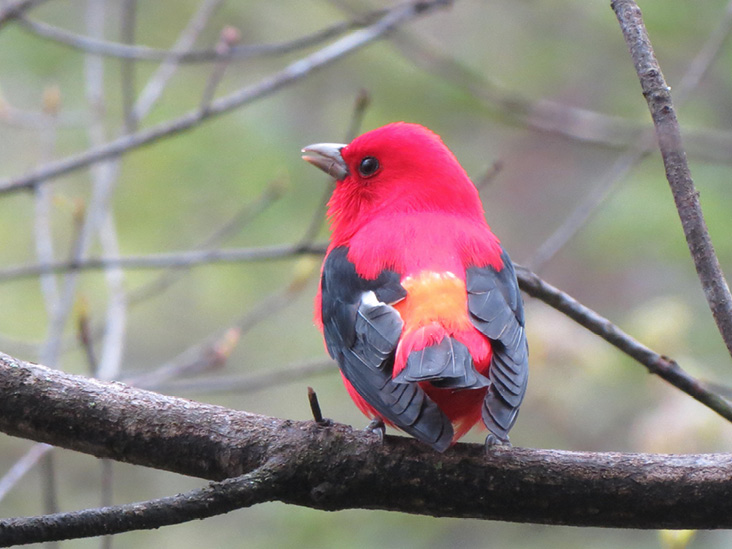
Scarlet Tanager. All photographs by the author.
During late 2017, I began reading about 2018 being the Year of the Bird. The National Geographic Society and its partners urged people to "take a simple but meaningful action each month" to support birds. In response, I started to think about conducting a birding project right here in my home town of Reading, Massachusetts. Having lived and birded here for more than 38 years, I felt that I had a good handle on the birds of Reading. However, I was curious about the trends in our bird populations. I have noted the disappearance of Ruffed Grouse, Ring-necked Pheasant, American Kestrel, and breeding Prairie Warblers. Conversely, I am now seeing birds I never saw when I first started birding in Reading. Red-bellied Woodpecker and Carolina Wren can now be seen almost daily, and sightings of Bald Eagle and Common Raven are now possible.
Ultimately, I decided to conduct a collaborative, townwide Big Year in 2018. My primary goals were to celebrate the Year of the Bird and to get more people interested in birding in Reading. Besides having fun, I hoped to get more local residents involved in collecting data about our birds. By doing so, it was my hope that town residents would gain a deeper understanding and appreciation of the birds in Reading. Additionally, I felt that the information gathered could be shared for planning and historical purposes with the local town boards, MassWildlife's Natural Heritage & Endangered Species Program, the three local watershed associations serving Reading, and any other group needing the information. Eventually, I would like to use the Big Year data along with historic bird records I have obtained and my knowledge from almost 40 years of birding in Reading to create a Birds of Reading checklist.
I discussed my idea with David Swain who had previously conducted his successful three-year Concord Birds Project. He gave me a lot of encouragement as well as tips on how to use the Cornell University online database, eBird, for data collection. I called the project BirdReadingMA and set up an eBird account to collect and share sightings in Reading. I contacted a number of friends in Reading who I knew had an interest in birding and explained the project to them along with the details of how to participate. I provided directions on how to get an eBird account and how to submit their sightings to the BirdReadingMA account. However, I did not want to discourage people from participating who, for whatever reason, did not want to use eBird. I provided everyone the option of sending me their sightings at birdreadingma@gmail.com. I then entered these emailed sightings into the BirdReadingMA account. I also shared this information on the Massbird email list for birders who might have been interested in helping out with this project.
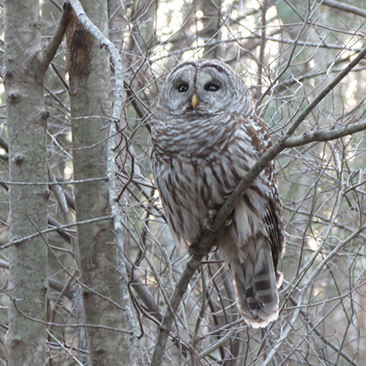
Barred Owl.
To encourage more local residents to participate, I knew I would need a "hook" to spark their interest. I decided to make several presentations at the local library that I thought would be of interest to nonbirders. I decided that my first presentation would be called, "A History of the Birds of Reading." As it turned out, preparing this talk was the most enjoyable and rewarding component of the whole project for me. The research involved in putting this presentation together took me to interesting places.
I began by collecting observations to generate a Town of Reading bird list which, when this project kicked off, stood at 180 species. This list was compiled from numerous sources including my personal sightings from 1980 to the present, Town of Reading Annual Reports 1968–1970 submitted by David Galvin, and "On The Wing" columns from the Reading Chronicle 1965–1970 written by David Galvin. Included in these columns are sightings reported by Ann Blaisdell who led bird walks for the Reading Garden Club from 1965–1972. David Galvin was generous with his time. Now living in Seattle, he provided me with stories and a list of birds from his growing up in Reading.
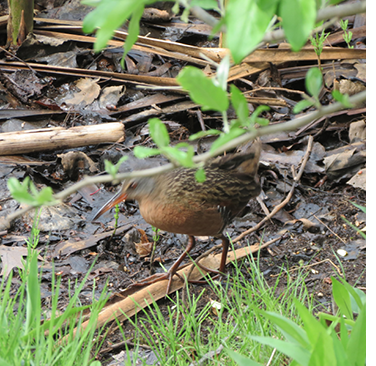
Virginia Rail.
During my research, the name Whitney Nichols, a former Reading resident and birder, kept appearing. After numerous attempts, I finally made contact with him. In several email and phone conversations, he provided me with a wealth of birding information for the town, including a couple of bird lists from the late 1950s.
Marj Rines of Bird Observer sent me Reading sightings that she had gleaned from eBird. Sightings also included personal records provided in correspondence with long time Reading resident and birder Ida Girunias. John Keely, Mark Daley, Carol Sandberg, Kim and Will Finch, and others also shared their historical Reading sightings with me.
As a child, I remembered my parents filling out a postcard and sending it to the Massachusetts Audubon Society when they saw a Northern Cardinal at our feeder. I reached out to Wayne Petersen of Mass Audubon, and he provided me with copies of the Massachusetts Northern Cardinal and Tufted Titmouse census cards that were collected when that census was conducted in the 1960s.
I also used the book, At Wood End, for my research. This book was published in 1994 to celebrate the Town of Reading's 350th birthday. This coffee-table book was loaded with helpful old photographs, documents, and anecdotal stories.
In my presentation titled "A History of the Birds of Reading," I used photographs, documented sightings, and historical records to explore the history of birds in Reading and how the diversity of species has changed over the past 60 years. A large and enthusiastic crowd helped to make the presentation a success. So much so, that I gave an encore presentation a month later at the local bookstore.
The other two presentations I conducted, "The Mysteries of Bird Migration" and "Hawks, Owls, and Eagles of Massachusetts" were not as well attended as the first. I reached out to Reading residents for their photographs of hawks, owls, and eagles for the latter presentation.
Additionally, I led eight bird walks in town that were generally well attended by Reading residents. Most of the participants were new to birding and enjoyed not only the birds but also the open spaces. Many people on these walks were not previously aware of the conservation land and open spaces available to them. Reading may not become a birding destination for avid birders, however, it contains wonderful birding opportunities for people who want to explore the many parks, schools, backyards, cemeteries, and conservation lands.
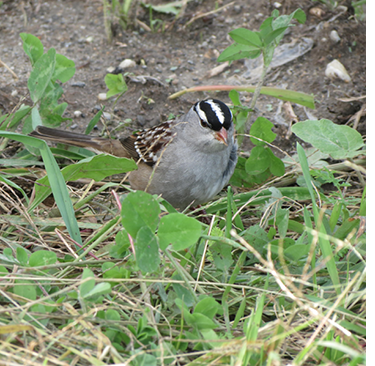
White-crowned Sparrow.
During 2018, both the local newspaper and magazine published articles that focused on the project. The article in The Readings magazine included numerous photographs of Reading birds that I had taken. Both of these publications were well received by the local residents and generated interest in the project.
The BirdReadingMA project ended up identifying 139 species (Table 1). In excess of 17,000 individual birds were seen and more than 30 people contributed 270 reports, either to eBird or to me directly. Observations came from 33 locations in town. By far the most heavily birded area was the Reading Town Forest, a 290-acre site in the northwestern part of the town. See Figure 1 for the map. The lifeblood of the Town Forest is the Ipswich River and its adjacent wetlands. The river serves as the boundary between North Reading and Reading. There is an abundance of old dirt roads that were previously used by the water department, as well as many well-marked walking trails. Both provide easy access for birding.
Bare Meadow Conservation land, an 84-acre parcel in the northeast part of town with ample access, was the second most birded area. A highlight of this site is the last remaining meadow in town. I previously wrote a "Where to Go Birding" article about Bare Meadow (Williams, D. 2011. Bare Meadow Conservation Area, Reading, Massachusetts. Bird Observer 39(5): 245–250.).
There were many birding highlights for me during the year. One early June morning, a friend and I got an early start and canoed on the Ipswich River. We paddled briefly upstream under Interstate 93 into Wilmington before heading back downstream and through the Reading Town Forest. The conditions were beautiful. We saw and heard Virginia Rails, Marsh Wrens, Yellow Warblers, Common Yellowthroat, Wood Ducks, Chimney Swifts, Swamp Sparrow, Baltimore Oriole, Willow Flycatcher, and Barn, Tree, and Rough-winged swallows. A great morning of birding!
Another highlight for me was the Town Forest walk I led on May 27, 2018. Only four people showed up, but we had some really nice birds including Virginia Rail, Willow Flycatcher, Great Crested Flycatcher, Wood Thrush, and many more. But the best moment was the appearance of a very cooperative Mourning Warbler. Its loud song froze us in our steps and then it popped up only 10 feet away. For five minutes we were able to watch it move about and listen to its call. It was a town life bird for me.
It was particularly gratifying to see the excitement and enthusiasm people showed when they reported a special bird. Eastern Bluebird, Ring-necked Pheasant, Pileated Woodpecker, Wood Duck, Yellow-bellied Sapsucker, Eastern Kingbird, Indigo Bunting, and Fox Sparrow were all birds that participants were excited to report. For these folks, I hope that their enthusiasm will continue and they will be motivated to bird even more.
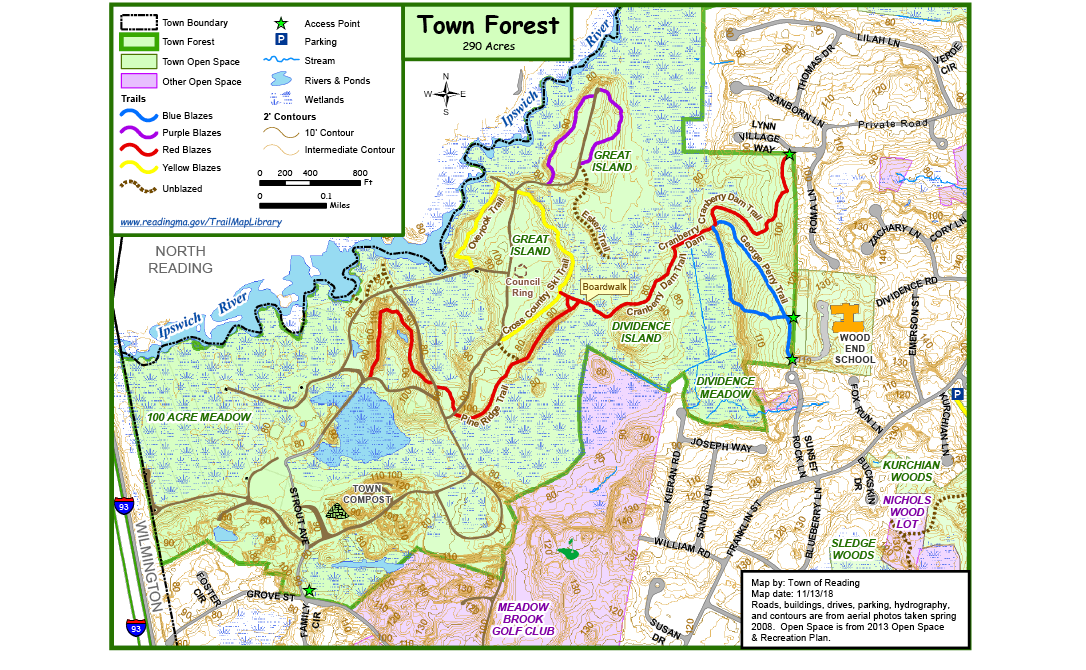
Figure 1. Map of the Town Forest in Reading, Massachusetts.
I was pleased with the twenty species of warblers reported during the project, however, it was disappointing not to see a single Prairie Warbler, knowing that they nested here in town just 25 years ago. Eight duck species were reported with Common Merganser being the highlight. Overall, the number of ducks was less than what I expected. No falcons were seen in 2018, but there were a lot of good reports of the seven species of hawks observed. Northern Harrier, Red-shouldered Hawk, and Osprey were notable. Great Horned and Barred owls were reported in good numbers, but only three reports of Eastern Screech-Owl were made. The Northern Saw-whet Owl still eludes the town list despite several attempts to locate one. Eleven species of sparrows was better than expected. Notable was the town's first Grasshopper Sparrow. There was only one report of Eastern Towhee, another former breeder here in town. While six species of woodpeckers were to be expected, the numerous reports of these birds were very satisfying. The project did not miss out on the eruption of winter finches with reports of Evening Grosbeak, Pine Siskin, and Purple Finch; Red-breasted Nuthatch was also reported.
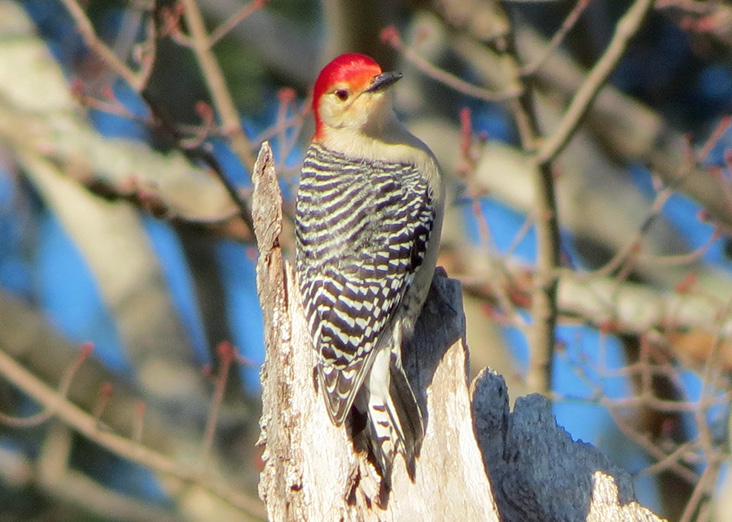
Red-bellied Woodpecker.
The changes in bird populations in town are not unexpected and reasons probably include natural succession of field to forest leading to a lack of forest diversity, encroaching development contributing to habitat loss and degradation, the warming climate, and forest fragmentation. These reasons mirror what is going on in the state as well as the country. The town of Reading has done a good job in setting aside land for conservation. The town also established a Trails Committee 10 years ago, and they do a wonderful job keeping the trails in good condition and promoting them. They co-lead an annual "Birds Before Breakfast" walk. However, they are limited in scope as to active land management.
Table 1. BirdReadingMA Project Results (First sightings by date in 2018)
The terms "birding" and "bird watching" are now part of the town's lexicon, in part, due to this project. Bird watching is acknowledged and advertised as a recreation activity for residents. The challenge now before those of us who enjoy Reading's open spaces is the management of these properties. The Trails Committee and several concerned residents have approached the Conservation Commission about beginning to actively manage the lands. This discussion has been aided by this project. There is an effort afoot to restore the meadow in Bare Meadow to what it historically used to be, thus benefitting the American Woodcock that breeds here. A forester has been consulted to see what management options there are for the Town Forest. The Town Forest was created in April, 1930 when over 100,000 red and white pine, spruce, balsam, and scotch pine trees were planted by local Boy Scouts and other interested citizens. The "pine plantations" are now mature forests, almost 90 years old. It has become a monoculture that needs to be thoughtfully addressed if a healthy, diverse forest is desired. A sustained commitment to managing these properties will take effort and money.
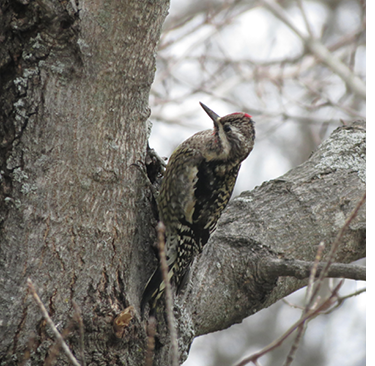
Yellow-bellied Sapsucker.
One year of data collecting can't answer all questions, but it can certainly generate questions for further inquiry. I would like to invite readers to make at least one birding trip to somewhere in Reading and then share their Reading eBird trip lists and field notes with BirdReadingMA. Trail maps of conservation lands in town are available at: https://www.readingma.gov/trailmaplibrary.
I plan to continue the BirdReadingMA project for two more years. There is still much to be learned about the town's birds and their habitats. A big challenge is to access the Cedar Swap land on the eastern boundary. This 400-acre-plus swamp on the Reading, Lynnfield, Wakefield line is bordered by private property, the Reading Rifle and Revolver Club, and Camp Curtis Guild National Guard Camp with virtually no public trails. My only foray into this area along what I believed to be a gas line easement ended up in a confrontation with a home owner who claimed I was trespassing. Additionally, the swamp land in the southeast part of town bordering Wakefield along Walkers Brook and the B&M railroad tracks still needs to be explored. Again, access will be a challenge.
As part of this project, I will be conducting a collaborative Big Day in Reading on Saturday, May 18th, 2019. I hope that this event will generate enthusiastic participation from local residents and show them the fun and enjoyment from patch birding. There is no need to travel far and wide to learn about the pleasures of birding when the birds can be found in your hometown!
Dave Williams has lived in Reading, Massachusetts, all his life. He has been birding for more than 40 years. He is a retired middle school science teacher. He is a volunteer teacher/naturalist at Mass Audubon's Joppa Flats Education Center.